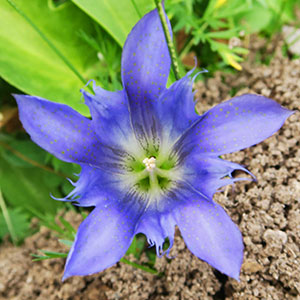Gentiana newberryi
Gentiana algida
alpine gentian, Newberry's gentian
arctic gentian, whitish gentian
1–5, arising laterally below rosettes, from a stout tap root, tufted, decumbent.
1–few, arising laterally below rosettes or seemingly from center of rosettes because of large basal leaves, decumbent to erect.
basal and cauline;
blades of basal rosette and proximal cauline leaf blades widely spatulate to obovate or oblanceolate, 0.8–5 cm × 2–25 mm, apex obtuse or mucronate, at least these leaves with blades less than 6 times as long as wide, distal cauline leaves few, with blades oblanceolate to lanceolate or linear, 2–5 cm × 2–5 mm, apices acute.
basal and cauline;
blades of basal and rosette leaves narrowly spatulate, 2–10(–14) cm × 1–7 mm, transitional to cauline leaves with blades oblanceolate to lanceolate or linear, 2–5 cm × 2–5 mm, blades of all leaves 6+ times as long as wide, apices obtuse to acute.
terminal, flowers usually solitary, occasionally 2 or 3.
1–3-flowered.
calyx 14–30 mm, lobes linear to narrowly ovate, (4–)6–12 mm, margins not ciliate;
corolla white or blue, campanulate, open, 23–55 mm, lobes spreading, elliptic-obovate, 7–17 mm, free portions of plicae divided into 2 triangular, serrate to lacerate segments;
anthers distinct.
calyx 15–28 mm, lobes linear to lanceolate, (5–)7–12 mm, margins not ciliate;
corolla abaxially suffused with blue-violet on and below lobes, adaxially white or yellowish white with dark purple and/or greenish spots and streaks, funnelform, open, 35–50 mm, lobes ascending to spreading, ovate-triangular, 2–5 mm, summit of plicae nearly truncate, erose;
anthers distinct.
winged.
winged.
= 24.
Gentiana newberryi
Gentiana algida
Varieties 2 (2 in the flora).
The two varieties of Gentiana newberryi intergrade extensively. The most distinctive form of var. newberryi, with relatively tall stems and medium to deep blue corollas, occurs in the northern part of the range of the species, from the Klamath and White mountains of California north into Oregon. Plants most clearly referable to var. tiogana prevail in the southern part of the range of the species, from Butte County south to Inyo and Tulare counties, California. In the central part of the range of the species, plant size and corolla color are less consistently correlated, with occasional plants combining low stature with deep blue corollas or tall stems with predominantly white or pale blue corollas. In that part of the range, corolla color may be highly variable within a single population.
The leaves of Gentiana newberryi are thick-textured and distinctively concave, usually spoon-shaped, when fresh. Narrower leaves sometimes occur in var. tiogana, but many plants of that variety have widely spatulate leaves like those of var. newberryi.
(Discussion copyrighted by Flora of North America; reprinted with permission.)
Gentiana algida of North America and Asia is sometimes considered conspecific with G. frigida Haenke of Europe. Early reports of differing chromosome numbers have been superseded by more recent counts indicating that 2n = 24 prevails in both species. If these taxa are united, the North American plants can be called G. algida var. algida. This designation is also applicable if varieties are recognized among the Japanese or other Asiatic representatives of this species.
(Discussion copyrighted by Flora of North America; reprinted with permission.)
1. Corollas medium to deep blue with greenish to dark purple lines abaxially on and below lobes, usually 35–55 mm. | var. newberryi |
1. Corollas white to pale blue except for greenish to dark purple lines abaxially on and below lobes, usually 23–42 mm. | var. tiogana |


